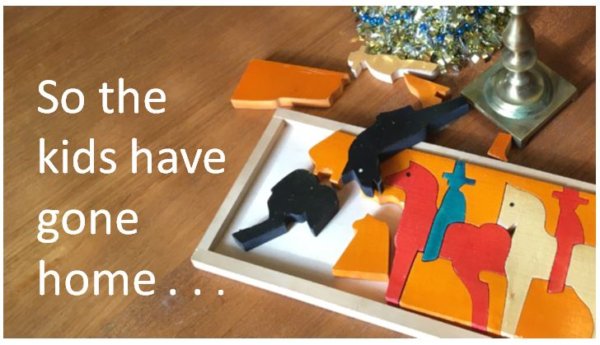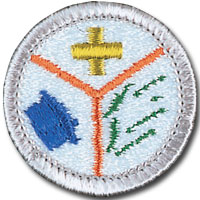Including Kids In Preparedness Planning

Over the holiday I met some new family members. We have a VERY extended family with multiple generations so new people become attached to the group pretty regularly –new boyfriends, new girlfriends, new husbands of ex-wives, including kids of all ages. You get the picture!
All the original husbands and wives seem to stick, too, along with their children, so the assemblage just keeps expanding.
Three new kids were added this year.
At this year’s Thanksgiving party we had some new children added to the older teens in the mix — two girls around 6 years old, and a boy about 12. (The puzzle in the photo is one of my go-to toys for all new kids. It’s surprisingly difficult!)
Naturally I started talking with these children and some of my questions had to do with preparedness and their grasp of good habits for safety and security.
My questions were shaped in part by several sobering articles I’ve read lately.
As you can imagine, the chances are very good of a child being away from parents when an emergency hits. According to the CDC, 69 million children are separated from their parents each work day as they go to school or child care! Moreover, while most parents seem to think they’ll be reunited “within a few hours” after an emergency, the truth is not so benign. In fact, it took 7 MONTHS for the last child to be reunited with family after Katrina!
So I’m concerned about children. When an unprepared child faces an emergency, that child’s response is likely to be fear. Fear deprives the child from being able to make a decision. The prepared child has the chance to respond from a position of strength and confidence. What a gift!
What can we do to help kids be more prepared?
1 – Actively include children in our planning.
There are different levels of preparedness planning.
Level one – be prepared to get out of a dangerous situation.
Level two – know about safe places to go to if you can’t stay at home.
Level three – Have an idea of what to expect if . . .
You can work on all three of these levels using simple questions. The answers would depend on the age and experience of the child.
For example, here’s a simple question: “If you smelled smoke in the house right now, what would you do?”
It’s easy to follow it up with more questions or more details, depending on whom you’re talking to. I always have lots of one-liners like this at the ready!
(I remember a few years ago writing about how I got my teenaged grandchildren to figure out how to climb out the second floor window onto the roof, then to the pergola where they could drop to the ground.)
2 – Build life skills.
I was lucky in that my parents were true pioneers living in the wilds of Alaska, so they had real, outdoor survival skills that I inherited even though I grew up in a town. I’m talking about how to swing an axe, how to tie a knot in a rope, etc. Now your children may be growing up in suburbia, where cutting down trees isn’t advisable (!), but they can still learn basic skills:
- How to swim.
- How to light a fire.
- How to climb out the second floor window onto an escape ladder.
- How to assemble a piece of furniture using hand tools.
- How to repair a bicycle.
In my own experience, and based on everything I’ve read, the more “capable” a child is at figuring out how things work, managing tools, building or taking things apart – the more confidence she’ll have facing any challenging situation.
3 – Repeatedly test kids’ level of awareness.
I think this discussion lends itself to a sport analogy. If you are on a soccer team, you need to know where you are on the field, where the other players are, their general direction and speed, where the ball is, where the goal is, etc. Great players seem to be able to carry all this in their heads and body all the time!
From the point of view of children and being prepared, it’s the same concept. For example, you can check in with your child as you are driving:
- Where are we? (Name of street? How far from home or school? Where do we turn next?)
- Name some of the things you see around us. (Street lights. Bicycles. Cars moving. A taxi letting someone off. A dog running loose.)
- Do you see other people? What are they doing and how fast are they going? What is likely to happen when they reach a certain point?
- Could something bad happen? (If that bicyclist came across in front of us, we would hit him. That dog could run right into the street and all the cars would swerve to miss him.)
- What could we do?
The amount of detail that a child would notice will depend on age – and practice! And the conversation doesn’t need to include all these questions – it might be made up of only one.
“Wow, see that dog? What do you think he’s going to do next?”
For sure, your child will be unable to answer a single question if he/she is buried in a digital game or on a cellphone. For that matter, so will your wife.
Let’s create a list of good ideas for kids!
I’d like to capture some more good ideas from readers and share them with others. For example:
- A mother in my LinkedIn group writes that every night, before they head to bed, her children make sure all toys are picked up so nothing blocks their escape route. And the children close the door to their bedroom, too, for fire safety.
- The Centers for Disease Control reminds all parents, and particularly those of special ed kids, to have a list of emergency contact information in the child’s backpack. (If you laminate the page, it will last longer.)
- I’ve written before about my own concern about children who don’t know their first and last names. Of course it varies, but by age 5 they probably should know that important information and be able to respond when asked. Older kids need to know a contact phone number by heart. All these kids should know how to call 911.
So now, to finish this Advisory, I’d like to ask for your help. Surely there are hundreds of kids represented by the readers of Emergency Plan Guide!
What do you do with YOUR kids (or students) to help them be more aware of their surroundings, alert for potential danger, and ready to take action in an emergency?
Can you send me at least 3 good ideas for including kids in preparedness planning? I want to share all of them!
Virginia
Your Emergency Plan Guide team
P.S. Just scroll down the page to below the Advisory sign-up box to the Comment section. Or send me an email. In any case, I won’t use any names unless I get your approval first!

